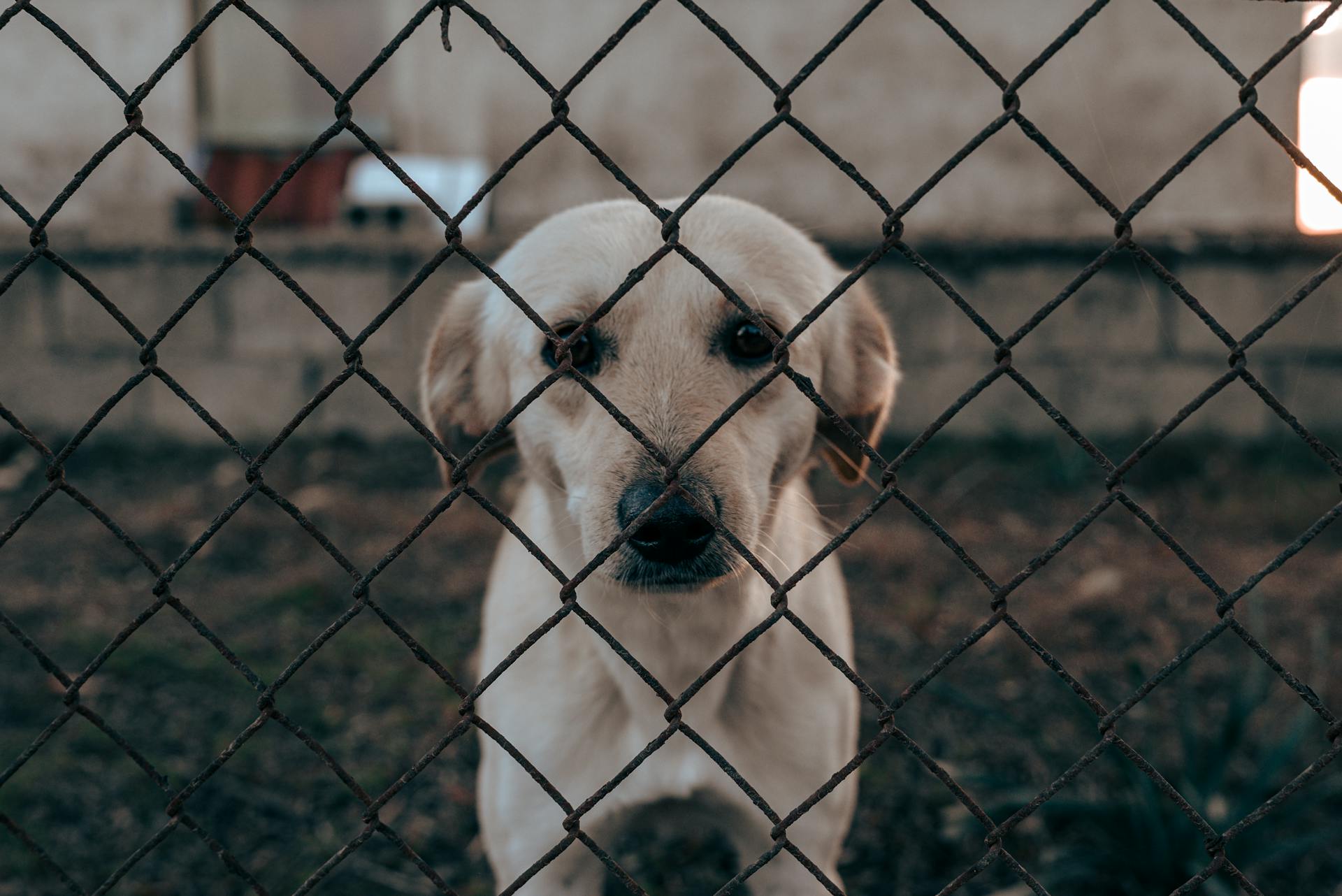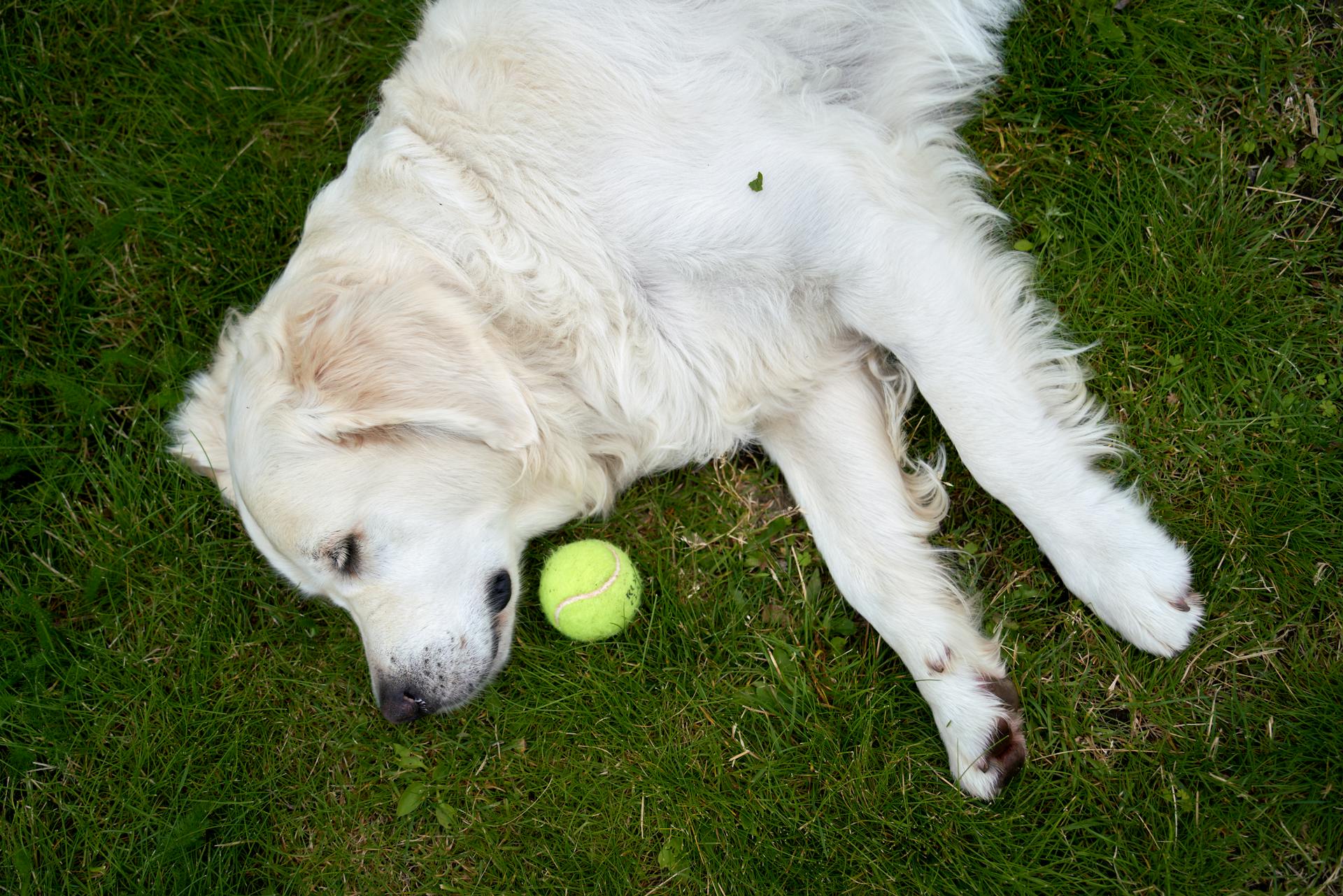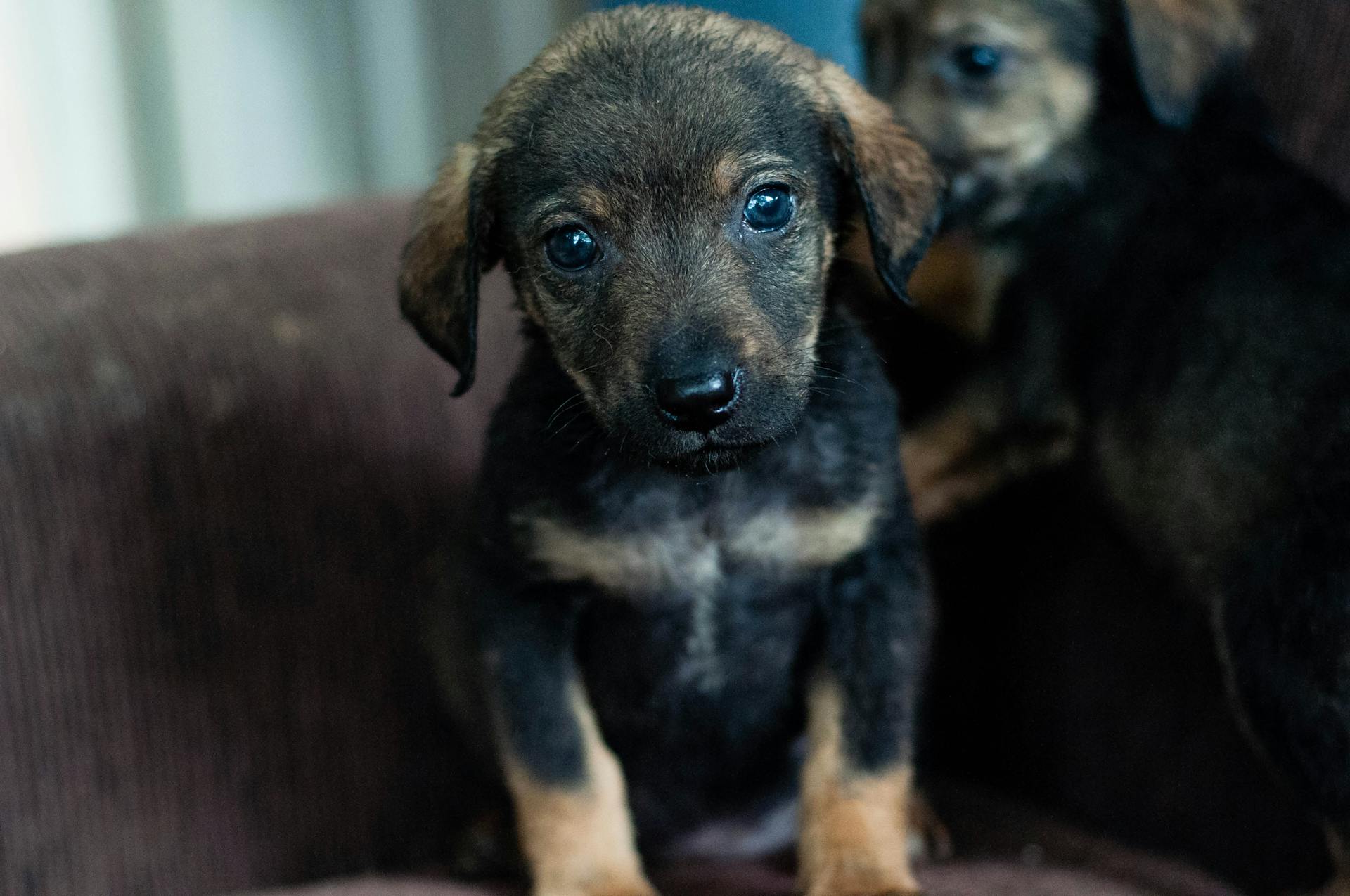
Resource guarding in 6-month-old puppies can be a challenging behavior to address, but understanding its causes is key to prevention. One of the primary causes of resource guarding in puppies is fear and anxiety.
Puppies that are not socialized properly may become fearful of people and other animals, leading them to guard their resources as a way of coping with their anxiety. This fear can be triggered by various factors, including genetics and early life experiences.
A puppy's environment plays a significant role in shaping their behavior, and resource guarding can be a result of inconsistent or harsh training methods. For instance, if a puppy is punished for growling or snapping, they may become more aggressive in the future.
A fresh viewpoint: What Causes Resource Guarding in Dogs
Understanding Resource Guarding
Resource guarding is a natural dog behavior, but it's not a desirable one. It's a natural animal behavior, hardwired into animal nature to protect the things we believe we need to survive.
Dogs engage in resource guarding when they perceive a threat to a valuable resource in their possession. This behavior could be as simple as a look, head turn, or slight baring of the teeth.
Resource guarding becomes a problem if a dog is willing to bite or fight to keep an item. Aggression around food, toys, or space can result in dog bites to humans or fights between pets.
Dogs do what works, and if they feel that their valued items are at risk of being taken away, they'll engage in various behaviors to avoid losing those items. They typically start with mild behaviors, such as stiffening up or staring intently at the person or animal in question.
Here are some common triggers for resource guarding in dogs:
- We tend to see this behavior more frequently in field-line gun dogs, such as spaniels and retrievers.
- Poor genetics/breeding and/or lack of early socialization.
- A history of harsh training methods, especially when started at an early age.
- The dog has had limited resources in the past, such as a dog that came from a puppy mill or hoarding situation.
It's essential to note that a dog resource guarding an item or space from a person is not displaying dominance-based behavior.
Identifying Signs and Triggers
Resource guarding in dogs can start with seemingly insignificant items, like a sock that's your dog's most beloved possession. Food and treats are common triggers, but other valuable items like bones and edible dog chews can also spark guarding behavior.
Dogs may exhibit resource guarding with their food bowl, whether it's filled with food or empty. In some cases, a dog may even guard the open dishwasher, reacting whenever you try to close the door.
Some signs of resource guarding include growling, lunging, and air snapping. If your dog is exhibiting these behaviors, it's essential to address the issue before it escalates. Here are some common signs of resource guarding:
- Growling
- Lunging and Air Snapping (a no-contact bite)
- Chasing you or another animal away
- Biting
In milder cases, you may notice more subtle signs, such as freezing, eating faster, or taking an item and moving away. These behaviors can be indicative of resource guarding and should not be ignored.
What Causes?
So, what causes these signs and triggers? Well, research suggests that genetics can play a significant role in the development of certain mental health conditions.

Stress is a major contributor to anxiety and depression, and can be triggered by a range of factors, including work, relationships, and financial difficulties.
Sleep deprivation can also exacerbate symptoms of mental health conditions, making it harder to manage emotions and behaviors.
A traumatic event can trigger post-traumatic stress disorder (PTSD), which can lead to symptoms such as flashbacks, nightmares, and avoidance behaviors.
Social media can be a significant trigger for anxiety and depression in young people, particularly if they experience online bullying or cyber harassment.
A person's upbringing and family environment can also contribute to the development of mental health conditions, particularly if they experience neglect or abuse.
Signs of
Signs of resource guarding in dogs can be subtle or intense. A dog might growl, lunge, or bite if it feels its resource is being threatened.
Freezing, eating faster, and taking an item and moving away are less intense signs of guarding behavior. A trained observer might notice these subtle signs before the more obvious ones.

Some dogs will bracingly position their body over the item, or subtly shift their body weight to block it. Others might give a hard stare, or raise their lips and bare their teeth.
Here are some common signs of resource guarding in dogs:
- Growling
- Lunging and Air Snapping
- Chasing you or another animal away
- Biting
And here are some more subtle signs:
- Freezing
- Eating faster
- Taking an item and moving away
- Braced body position over the item
- Subtle shifting of body weight to "block" the item
- Side eye staring or tracking of the person or pet approaching
- Raising lips and baring teeth
- Ears pinned flat against the head
- Hard stare
Items That Trigger
Any item that a dog deems valuable can trigger resource guarding behavior. Food and treats are a common trigger, but it's not just about the food itself.
Food bowls, whether filled with food or empty, can also be a source of tension. A dog may guard their bowl fiercely, making mealtime a challenge.
Bones and edible dog chews are another type of item that can trigger resource guarding. In one case, a dog became so attached to a lamb spine chew that they growled when their owner approached.
A table can help illustrate the common items that trigger resource guarding:
It's essential to be aware of these triggers and take steps to prevent resource guarding behavior from developing.
Non-Food Aggression
Non-Food Aggression can manifest in various ways. A common trigger is when dogs feel their space is being invaded, whether it's their dog bed, crate, or even their position on the couch or bed.
Some dogs may become possessive about specific items, such as toys, tissues, napkins, socks, or laundry items. These items can become "contraband" that the dog feels the need to guard.
Dogs may also exhibit aggression towards people, not just because they're resource guarding, but due to fear-based aggression or leash reactivity. In fact, many owners assume their dog is "protecting" them, but it's often a case of the dog feeling anxious or fearful around people.
Here are some common triggers for Non-Food Aggression:
- Toys
- Stolen "contraband" (tissues, napkins, socks or laundry items, shoes)
- Space (dog bed, crate, their position on the couch or bed, their feeding area)
- Their owner (from other pets in the home or even from other people)
Prevention and Management
Prevention is key when it comes to resource guarding in puppies. You can prevent resource guarding by setting your puppy up for success and teaching them that sharing is caring.
Don't leave valuable items lying around for your puppy to find and guard. This includes toys, shoes, and even laundry baskets. Keep your laundry basket up high to prevent your puppy from getting into it.
Feeding your puppy in a separate and secure area away from other pets can also help prevent resource guarding. And, of course, never free-feed your puppy.
Here are some proactive training exercises you can do to prevent resource guarding:
- Teach your puppy to come when called to avoid approaching them when they're guarding something.
- Gradually introduce new items and toys to prevent over-attachment.
- Use positive reinforcement training to encourage sharing and good behavior.
By following these tips and being proactive, you can help prevent resource guarding in your 6-month-old puppy. Remember, prevention is always easier than treatment!
Desensitization and Counterconditioning Training
Desensitization and Counterconditioning Training is a crucial step in changing your puppy's resource guarding behavior. This process helps your puppy learn to associate your approach with good things, rather than fear and anxiety.
The goal of desensitization and counterconditioning training is to change your puppy's emotional response to your approach and removal of the item they usually guard. Your certified dog trainer should be involved in every step of this process.
To start desensitization and counterconditioning training, you'll need to find a high-value treat that your puppy loves more than the thing they are guarding. Moist and smelly treats, such as small pieces of chicken or turkey hotdog, work best.
On a similar theme: Separation Anxiety in Dogs Crate Training
You'll also need to determine your puppy's distance threshold, the point at which they begin to resource guard. Start by giving your puppy their meal or chew as usual, then walk away. Approach your puppy from a distance beyond their threshold, toss a piece of chicken to them, and then turn and leave.
Here's a step-by-step guide to help you get started:
• Give your puppy their meal or chew as usual, then walk away.
• Approach your puppy, but stop a short distance beyond their distance threshold.
• Toss a piece of chicken to them.
• Once they eat it, toss another.
• Do this a few times, then turn and leave.
• Continue this exercise any time your puppy has something they guard.
Remember to start slow and don't rush through the process. With practice and consistency, your puppy will learn to anticipate good things when you approach them.
Safety and Emergency
Resource guarding in 6 month old puppies can quickly escalate into a serious situation, making it essential to prioritize their safety and yours.
A puppy's resource guarding can lead to biting and growling, especially if they feel their food or toys are being threatened.
If you notice your puppy's resource guarding is becoming aggressive, it's crucial to intervene immediately to prevent any accidents.
Keep a safe distance from your puppy during meal times to avoid triggering their resource guarding behavior.
In case of an emergency, it's essential to know what to do. If your puppy bites you, stay calm and slowly back away while giving them space.
If your puppy's resource guarding is severe, it's best to consult a professional dog trainer or behaviorist for personalized guidance and support.
Keep a close eye on your puppy during playtime to prevent any accidental bites or growling.
Consider reading: Growling Doberman Pinscher
Expert Guidance and Resources
Working with a certified dog trainer or behavior consultant is crucial when dealing with resource guarding in your 6-month-old puppy. They will help you stay safe and provide positive training to your dog.
Before seeking help, it's essential to understand that a one-on-one session with a certified trainer is necessary to assess the severity of your dog's resource guarding case. They will learn about your dog's behavioral history and current setup.
A certified trainer will build a trainer-client relationship with you and your dog, helping you through the steps to address resource guarding. They will also provide management techniques to keep you and your dog safe.
It's difficult for trainers or consultants to give specific advice without a one-on-one session, so don't rely solely on online resources. Safety should be your top priority when dealing with resource guarding.
Suggestion: How Old Is Too Old to Clip a Dog's Ears?
Frequently Asked Questions
Will a puppy grow out of resource guarding?
Puppies do not outgrow resource guarding, but rather develop it as they mature. Early training and preventive measures are crucial to address this behavior
Sources
- https://www.preventivevet.com/dogs/resource-guarding-in-dogs
- https://peachonaleash.com/resource-guarding-why-it-happens-and-how-to-stop/
- https://www.dogsnaturallymagazine.com/resource-guarding-puppies/
- https://www.instrideazawakh.com/post/resource-guarding
- https://www.whenhoundsfly.com/resource-guarding-dog-growls-to-protect-his-bone/
Featured Images: pexels.com


